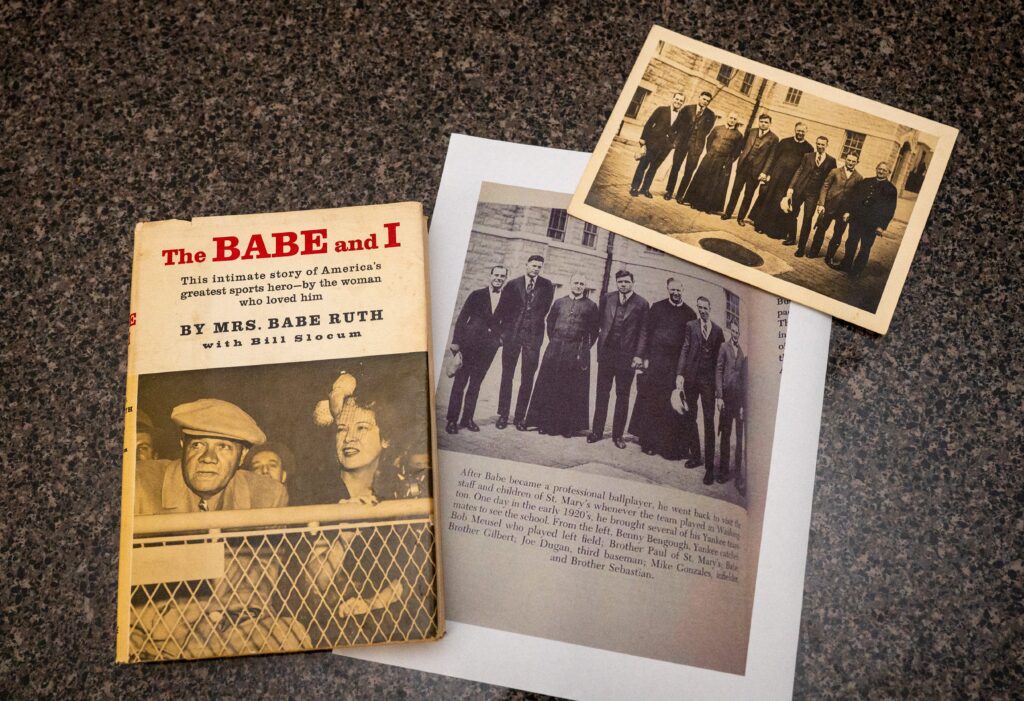
BALTIMORE (OSV News) — The legacy of George Herman “Babe” Ruth continues to grace his native town more than a century after his rise to international baseball renown.
Largely considered one of the most influential sports figures of all time, the “Sultan of Swat” has blessed the archbishop of Baltimore with an unexpected reminder of Ruth’s Baltimore roots and the Catholic Church’s role in his rise to stardom.
Archbishop William E. Lori in December received a photograph of Ruth in his prime taken during a visit with his New York Yankees teammates to St. Mary’s Industrial School in Southwest Baltimore. Ginny Black of Mount Pleasant, South Carolina, who discovered it among her late mother’s possessions, mailed the photo to Archbishop Lori.
“You may already have this image but if not we thought it was important to get to you,” Black wrote.
Alison Foley, archivist at St Mary’s Seminary and University in Baltimore, did some research on the photo and found it was published in the 1959 book “The Babe and I” by Ruth’s widow, Claire.
Curators at the Babe Ruth Birthplace and Museum examined the photo, which simply has “St. Mary’s Industrial School” hand-written on the reverse, and said that it was likely an aged reproduction. However, museum personnel said they had never seen the photo other than in Claire Ruth’s book.
The photo includes Babe Ruth posing in front of St. Mary’s Industrial School with teammates Benny Bengough, Bob Meusel, Joe Dugan, and Mike Gonzales as well as St. Mary’s Xavierian Brothers Paul, Gilbert, and Sebastian.
Throughout his career, Ruth remembered his roots and supported St. Mary’s Industrial School.
His parents sent Ruth, considered an “incorrigible,” to St. Mary’s when he was seven years old. He spent 12 years there and throughout his life credited the Xaverian Brothers, who operated the school for orphans and delinquents, for putting him on a better path.
He especially credited Xaverian Brother Matthias (Martin Leo Boutlier) for firm guidance and teaching him to play baseball.
Ruth was such a good player as a teenager that he caught the eye of famed general manager Jack Dunn of the Baltimore Orioles, members of the International League. Ruth signed a contract with the Orioles at 19, but the local team sold his rights and contract to the mighty Boston Red Sox of the American League.
With the Red Sox, Ruth developed into one of the best two-way (pitching and hitting) players in baseball, guiding Boston to World Series titles in 1915, 1916 and 1918. The cash-strapped Red Sox sold Ruth’s contract to the New York Yankees, where he blossomed into a prodigious power hitter and led the team to four World Series championships.
Ruth is buried in the Archdiocese of New York‘s Gate of Heaven Cemetery in Valhalla.
St. Mary’s Industrial School and the brothers “played a key role in his life when he needed it the most,” Archbishop Lori said.
The brothers “provided both discipline and mentorship as he grew into the man so many came to know on the baseball diamond,” he said. “We believe, and he certainly talked about, how being raised Catholic had a lot to do with his formation — as a person and a dedicated and successful professional baseball player.”
Meeting youth “where they are to teach them about God is most effective and so very important as they grow into adults,” Archbishop Lori said. “Babe Ruth had a passion and a great talent for baseball and if we, as those spreading the good news, can connect interests of the youth, whether it’s in sports, the arts or academics, to faith and to the words of Jesus, then we have offered a not only great gift to them personally but to the future of all humanity.”
“We know that Babe Ruth’s story is tied directly to the struggles he faced, especially in his youth,” the archbishop said. “He carried that along with him in his journey and knew his time at St. Mary’s played a crucial role, as Catholic institutions — parishes, hospitals, schools — have played in the lives of people of all walks of life.”
When Ruth attended St. Mary’s the enrollment topped 800 students and at one point the school cared for more than 1,200 boys. The Xaverian Brothers opened the school in 1866 and it closed in 1950. Its grounds were later used for Cardinal Gibbons School, which closed in 2010.
Katie Dick, director of external affairs at the Babe Ruth Birthplace and Museum, said Ruth often returned to St. Mary’s Industrial School to show his teammates the place where he learned to play. Mike Gibbons, director emeritus and historian at the museum, also said Ruth often visited the Baltimore school to make philanthropic donations.
Dick said he often took the St. Mary’s band on his national barnstorming baseball tours. Gibbons said Ruth supported the school financially, especially after a fire damaged the facility, and even bought a car for Brother Matthias.
Archbishop Lori also emphasized the importance of Ruth’s spirit of generosity.
Besides his donations to St. Mary’s, Ruth “supported hospitals, orphanages, and homes for disadvantaged children, making surprise visits and bringing them encouragement and gifts,” the archbishop said. “This speaks directly to the Catholic values of compassion and service, clearly something that was instilled in him early on.”
Archbishop Lori, who said he will “treasure” the photo from Black, noted that he shared a special connection with Ruth: The archbishop is a graduate of Mount St. Mary’s University in Emmitsburg, where legend has it the Babe was discovered by scouts.
– – –
This story was originally published by the Catholic Review, the news outlet of the Archdiocese of Baltimore, and distributed through a partnership with OSV News. Gerry Jackson is digital content coordinator at the Catholic Review.


